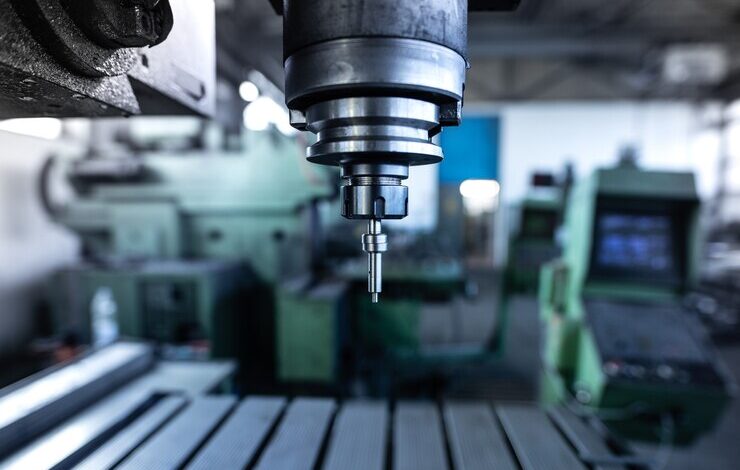Precision Perfected: CNC Vertical Milling Machines

CNC (Computer Numerical Control) vertical milling machines are pivotal tools in modern manufacturing, offering unparalleled precision and versatility. This article delves into the intricacies of CNC vertical milling machines exploring its applications, technological advancements, operational processes, and benefits in various industrial sectors.
Understanding CNC Vertical Milling
What is CNC Vertical Milling?
CNC vertical milling involves using computer-controlled machinery to remove material from a workpiece using rotary cutters. Vertical mills have vertically oriented spindles that allow for precise cutting, drilling, and shaping operations.
Components of CNC Vertical Mills
- Machine Structure: Overview of the base, column, saddle, table, and spindle head.
- Tooling System: Types of cutting tools (end mills, face mills, drills) and their configurations for different machining tasks.
Technology Driving Precision in CNC Vertical Milling
CNC Control Systems
- CAD/CAM Integration: Importance of CAD (Computer-Aided Design) and CAM (Computer-Aided Manufacturing) software in designing and programming machining operations.
- Precision Control: Role of servo motors, ball screws, and linear guides in achieving precise positioning and movement control.
Advanced Features
- Automatic Tool Changers: Mechanisms for automatically changing tools during machining operations to optimize workflow efficiency.
- High-Speed Machining: Techniques and technologies for achieving high cutting speeds and feed rates while maintaining accuracy.
Operational Procedures of CNC Vertical Milling Machines
Programming and Setup
- Programming Languages: Overview of G-code and M-code programming languages used to control CNC machines.
- Tool Path Generation: Process of generating tool paths from CAD models to guide machining operations.
Machining Processes
- Material Selection: Factors influencing material selection (metals, plastics, composites) based on application requirements.
- Milling Operations: Techniques for facing, contouring, pocket milling, drilling, and tapping using CNC vertical mills.
Quality Assurance
- In-Process Monitoring: Utilization of sensors and probes to monitor machining parameters (tool wear, temperature, vibration) in real-time.
- Post-Machining Inspection: Methods for inspecting finished parts to ensure dimensional accuracy and surface finish quality.
Applications of CNC Vertical Milling Machines
Aerospace and Defense
- Precision Component Manufacturing: Production of aircraft parts, turbine blades, and structural components with tight tolerances.
Automotive Industry
- Engine and Transmission Components: Machining of engine blocks, cylinder heads, and transmission housings to exact specifications.
Medical Device Manufacturing
- Implants and Prosthetics: Custom fabrication of medical implants and prosthetic devices using biocompatible materials.
Electronics and Semiconductor Production
- PCB Manufacturing: Precision milling of printed circuit boards (PCBs) for electronic devices and equipment.
Benefits of CNC Vertical Milling Machines
- Precision and Accuracy: Ability to achieve consistent part dimensions and surface finishes within micron-level tolerances.
- Productivity and Efficiency: Reduction in cycle times, minimized material waste, and increased throughput compared to manual machining.
Challenges and Considerations
- Initial Investment: Costs associated with acquiring CNC machines, software licenses, and tooling.
- Skilled Workforce: Importance of training operators and programmers to maximize machine utilization and operational efficiency.

Future Trends in CNC Vertical Milling
- Integration with Industry 4.0: Adoption of IoT (Internet of Things) and AI (Artificial Intelligence) for predictive maintenance and real-time process optimization.
- Advancements in Materials and Tooling: Development of new materials and cutting tools to enhance machining capabilities and extend tool life.
Conclusion
CNC vertical milling machines epitomize precision in modern manufacturing, offering enhanced capabilities and efficiencies across diverse industries in California and beyond. As technological advancements continue to drive innovation, businesses can leverage CNC vertical mills to maintain competitiveness, achieve superior product quality, and meet evolving market demands.
FAQs
What is a CNC vertical milling machine, and how does it differ from other types of CNC machines? A CNC vertical milling machine is a computer-controlled tool used for cutting and shaping materials vertically. It differs from horizontal milling machines in spindle orientation, allowing for precise vertical cutting operations.
Which industries commonly use CNC vertical milling machines? Industries such as aerospace, automotive, medical devices, electronics, and precision manufacturing extensively utilize CNC vertical milling machines. These machines are ideal for producing complex components with high accuracy and repeatability.
What are the primary advantages of using CNC vertical milling machines? Advantages include superior precision in vertical machining operations, versatility to handle various materials (metals, plastics, composites), automation of machining processes for efficiency, and ability to achieve intricate geometries and tight tolerances.
How does CNC technology enhance productivity in vertical milling operations? CNC technology automates machining tasks, reduces setup times, optimizes tool paths for faster cutting speeds, and minimizes manual intervention. This results in increased production output and reduced cycle times.
What types of materials can be machined using CNC vertical milling machines? CNC vertical milling machines can handle a wide range of materials, including metals (aluminum, steel, titanium), plastics (ABS, acrylics), composites, and wood. Material selection depends on specific application requirements and machining capabilities.
What steps are involved in programming a CNC vertical milling machine? Programming includes creating a design using CAD (Computer-Aided Design) software, generating tool paths using CAM (Computer-Aided Manufacturing) software, and converting designs into machine-readable G-code instructions. Operators load programs into the machine and set machining parameters.
How does quality control work in CNC vertical milling operations? Quality control involves in-process monitoring using sensors and probes to measure tool wear, temperature, and vibration. Post-machining inspections verify dimensional accuracy and surface finish quality to ensure parts meet specifications.



